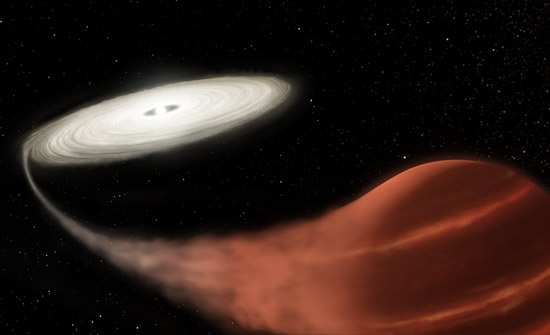U Geminorum star

Figure 1. U Geminorum star. A giant star that has filled its Roche lobe deposits material into the gravitational potential well of a white dwarf companion forming an accretion disk and "hot spot". © Swinburne University.

Figure 2. This illustration shows a newly discovered dwarf nova system, in which a white dwarf star is pulling material off a brown dwarf companion. The material collects into an accretion disk until reaching a tipping point, causing it to suddenly increase in brightness. Using archival Kepler data, a team observed a previously unseen, and unexplained, gradual intensification followed by a super-outburst in which the system brightened by a factor of 1,600 over less than a day.
A U Geminorum star, also known as a dwarf nova, is a type of cataclysmic binary that brightens abruptly and unpredictably by a factor of 5 to 250 (2 to 6 magnitudes). The rise to maximum takes less than a day and is followed by a decline to quiescence of several days or weeks.
U Geminorum stars, of which several hundred are known, consist of a white dwarf (or hot blue subdwarf) primary and an orange or red (K- or M-type) subgiant secondary that has grown to fill its Roche lobe (Figure 1). Each star has a mass of 0.5–1 solar mass and the orbital period of the system is 3–15 hours. Matter from the larger star enters an accretion disk around the dwarf, where it forms a hot spot, and from the inner edge of the disk spirals down onto the dwarf's surface. The light from a U Gem star, therefore, comes from four sources: the white dwarf primary, the cooler secondary, the accretion disk, and the hot spot.
Most of the time, a U Gem star shows small, sometimes rapid variations in light. Occasionally, however, the system will brighten rapidly by several magnitudes and then, over a period of days to months, return to normal. Such outbursts are assumed to be caused by the explosive nuclear fusion of hydrogen-rich material on the surface of the white dwarf.
Two competing theories have been proposed to explain the outbursts. In the mass-transfer burst model, an outburst stems from a sudden increase in mass transfer from the secondary. Such an increase may be triggered by an instability in the atmosphere of the cooler star. The sudden mass transfer may then cause the disk to collapse, dumping a load of fusionable matter onto the white dwarf. The rival disk-instability model postulates that the mass transfer from the secondary is relatively constant and that the relocated gas builds up steadily in the cool outer region of the disk, far from the white dwarf. When a critical surface density is achieved, thermal instabilities within the disk cause the matter to be accreted onto the white dwarf, giving rise to an outburst. The latter theory is currently favored because the instability offers a definite mechanism for the cause of the outburst, and simulations of outbursts based on the model have successful replicated many of the characteristics of U Gem eruptions.
The details of outbursts vary from system to system, but any given U Gem star will blaze up at semiregular intervals: the longer the interval, the greater the increase in brightness. The prototype, U Gem itself, remains at magnitude 13.5 for periods varying between 40 and 130 days, and rises to 9.5 or brighter in the course of a day or two, before reverting to its usual state over the next couple of weeks; it also experiences a minor minimum every 4h 11m as its larger, secondary component passes in front of the white dwarf primary.
U Gem subtypes include SS Cygni stars, SU Ursae Majoris stars, and Z Camelopardalis stars.


